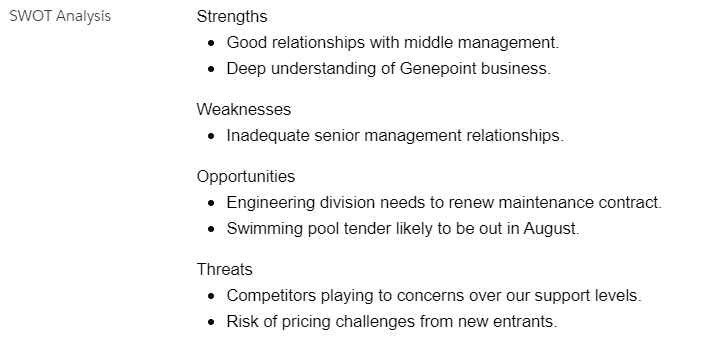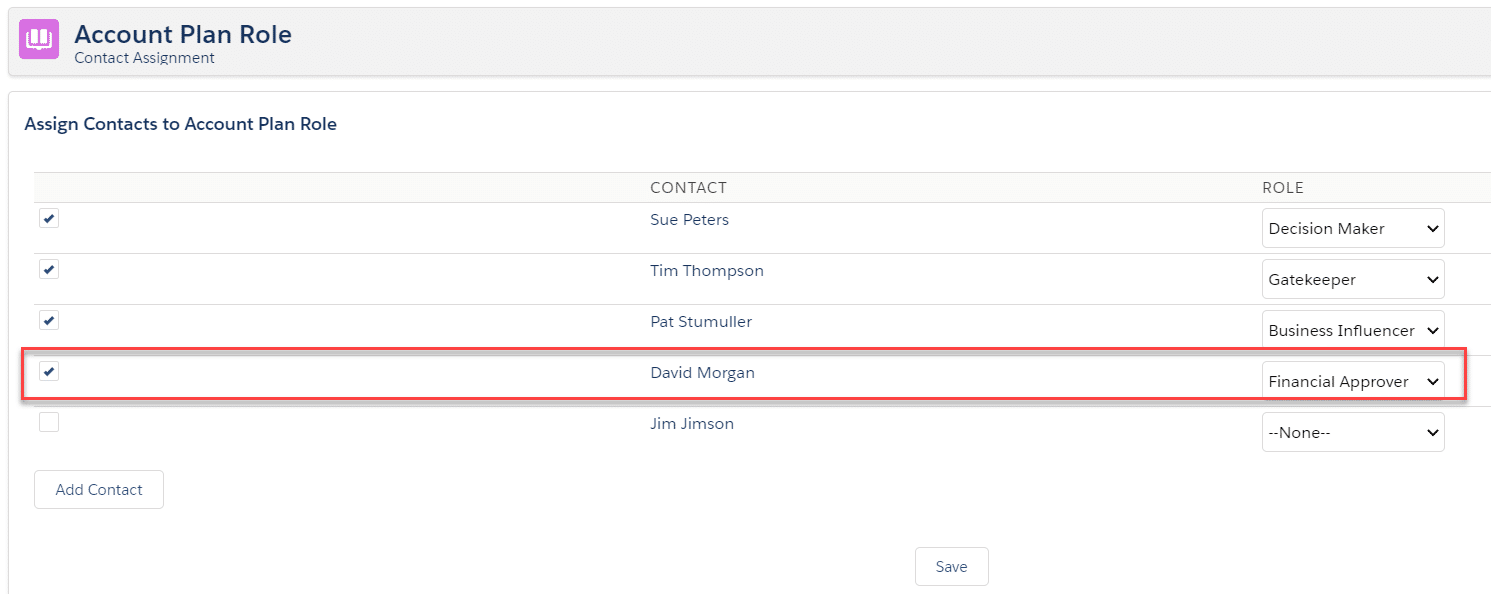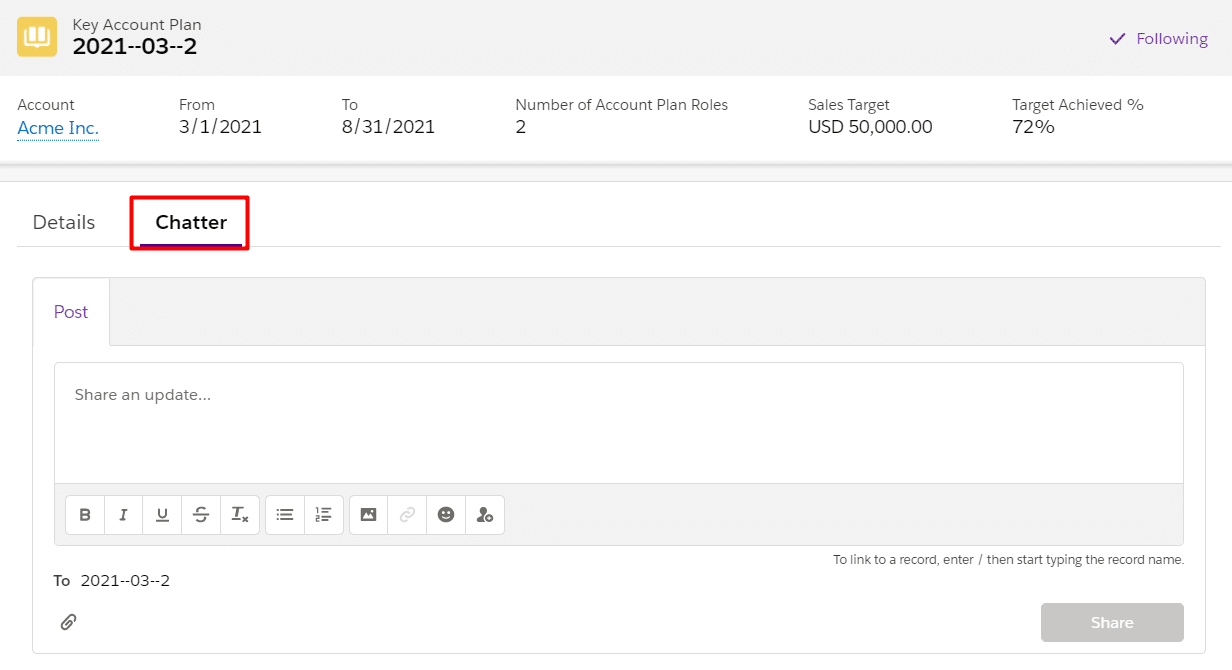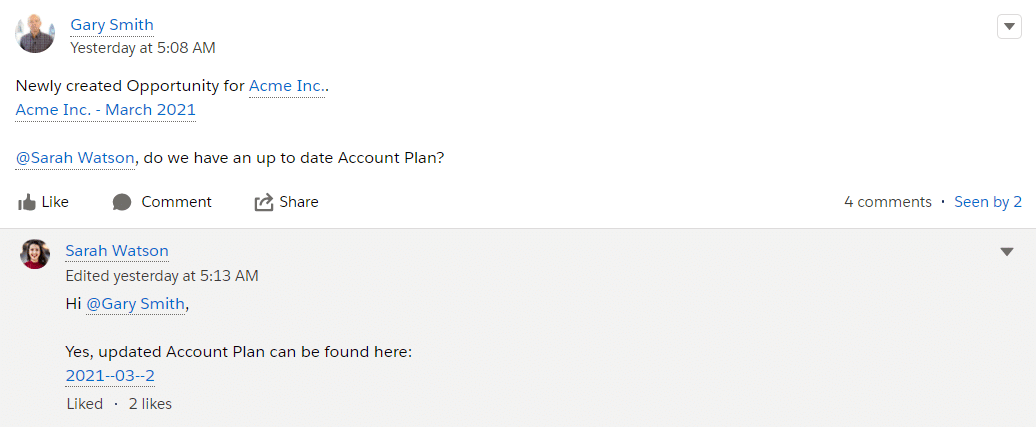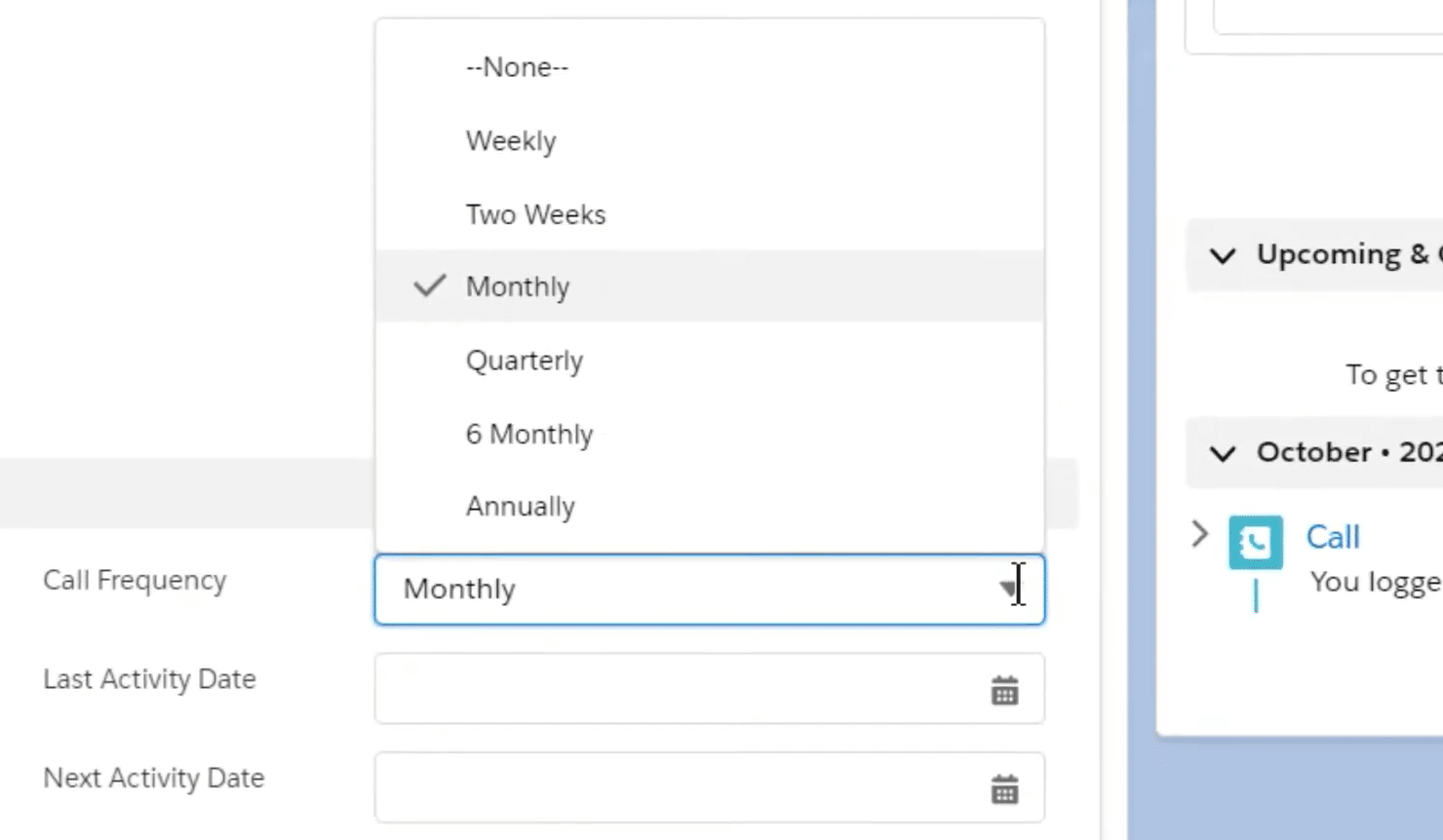How To Build Powerful Key Account Plans In Salesforce
In every business, there are customers and prospects for whom you need to create Account Plans.
These are the customers that deliver a hefty share of revenue and profits. And, they are the prospects who will become the income stars of the future.
Either way, strategic account plans are central to driving relationships and revenue in a profitable, sustainable, and mutually beneficial way.
However, there’s no Account Plan tab in Salesforce.
Fortunately, in this guide, I explain exactly how to create a compelling key account planning template in Salesforce.
Nevertheless, you might be wondering:
How do I get account planning up and running in Salesforce in my company?
You have a choice:
Build it yourself, using the screenshots and description in this article.
Or, buy the GSP Key Account Planning app on the Salesforce AppExchange. (If you’re wondering about the price, it’s $350 per month all in, unlimited users).
Let’s dive in.
Critical Key Account Planning Features
Executives conduct account development planning to set objectives, define business development plans, identify actions, track outcomes, and measure revenue targets for strategic customers and prospects over a specific period.
Here’s what any account planning tool must do:
- Help the team define the strategic customers and prospects in Salesforce.
- Measure sales revenue and income versus the target for each customer.
- Describe the account management strategy, white space opportunities, business development initiatives, action plan, and challenges for valuable customers and prospects.
- Highlight risks and threats likely to impact the success of the Account Plan.
- Help the team quickly identify when corrective or remedial action is needed.
With that in mind, let’s see how not to do it.
Avoid This Common Account Plan Mistake
Here’s what I recommend you DON’T do with Account Plans in Salesforce:
Create fields directly on the Account. For example:
In this example, there are fields on customer records in Salesforce that hold the key account plan details.
However, there’s no time associated with the plan (e.g., 2021). So, what do you do next year?
Answer: overwrite the plan from the previous year. Unfortunately, that means all the valuable information that you entered previously is lost.
You probably don’t want that.
Key Account Plans in Salesforce
I cover everything there is to know about creating effective Key Account Plans in Salesforce in the video below.
On the other hand, if you prefer to read and look at screenshots, scroll down to skip the video.
GSP Key Account Planner for Salesforce Video
Let’s break the GSP Key Account Planner down.
We use a custom object that relates to the Account.
In our example, we call it a Key Account Plan. However, name it Strategic Management Plan, Account Development Plan, or any other term that resonates in your business.
For each vital customer or prospect, create a Key Account Plan. The plan will typically be a quarter, half-year, or full year.
Here are some examples of fields you might create.
Account Plan Fields
These are the fields we include in our pre-built app. You can create others – or hide some of these fields if you wish.
Goals. The vital things you must achieve with this customer or prospect during the year.
SWOT Analysis. The strengths, weaknesses, opportunities, and threats to successfully achieving your goals.
Stakeholder Management Plan. Identifies the critical people at the customer and describes how you will manage and develop those relationships.
Support Required. People often overlook the importance of defining the internal resources you need.
Short Term Plan. The steps you will take over the next 2 to 4 weeks.
Create Key Account Plans that drive business
development and sales.
Of course, you update the fields throughout as relationships develop and new opportunities and threats emerge.
Key Account Plan Objectives
Next up, the specific objectives you plan to achieve during the lifecycle of the Account Plan.
Ideally, you want to aim for two to five objectives.
In each case, record the owner, current status, the date you aim to succeed, and other essential fields that describe how you will achieve the objective.
Don’t forget to include fields for the objective owner and manager to enter review comments.
Use these fields to enter information and lessons that will sharpen your account planning in the future.
Account Plan Metrics
It’s not enough to record how we will work to develop the customer or prospect.
We also need to record success.
These are the KPI fields we use in our strategic account planning app:
Sales Target. The value of won opportunities in the period. In some businesses, this needs to reflect the amount of scheduled revenue.
Won Revenue. The value of closed-won opportunities. Again, in other companies, this can be the value of scheduled revenue in the year.
Pipeline. The value of pipeline opportunities due to close during the Account Plan. Or the amount of scheduled revenue due to land in the period.
Weighted Pipeline. The pipeline opportunities are multiplied by the probability.
Total Expected Revenue. Expected Revenue is the value of closed-won opportunities plus the weighted pipeline.
Forecast Target Variance. The difference between the Sales Target and Total Expected Revenue.
Opportunities automatically link to the Account Plan based on the Closed Date. Whenever a deal is updated, the metrics automatically adjust.
Percentage performance on each KPI is on the right.
The in-line chart shows how revenue compares to the target.
The light blue column is the target; dark blue is closed-won; light green is the weighted target, and the dark green indicates Forecast Target Variance.
As a result, we can immediately see whether the pipeline coverage is big enough to hit the customer’s target.
Incidentally, here’s where you can get more tips and a full guide to all the fields and sections covered here:
How To Create Account Plans That Actually Work | Ten Best Practice Tips
How Opportunities Link To The Key Account Plan
Each time an Opportunity is created or edited, a code-based trigger links the Opportunity to the relevant Account Plan.
The value of all linked opportunities rolls up to the plan.
You can use the same approach if you bring invoices or import orders into Salesforce. We have code pre-built that can seamlessly link these records to the relevant plan.
Get in touch with us if you’d like to find out more.
Contact Roles on Account Plans
In this example, we have listed three people as playing a role in the Account Plan.
These are the people you must influence in a positive way to maximize the success of your business development effort.
In our app, you can easily add more people to this list.
This action is a valuable, practical step. We have to think through the contact roles at each customer to link the right people to the plan.
Often, it’s at this stage that we realize we are missing essential relationships. That means we need to locate and build new relationships with other significant players.
Partner Roles on Account Plans
Sometimes, other companies play an essential role in the success of your Account Plan.
For example, in the building industry, firms of surveyors, architects, engineers, and other companies impact your ability to win deals.
In your industry, there may be other external companies heavily involved.
Record these relationships using Partner Roles on the Account Plan.
The Partner Roles Assignment button allows you to add new companies to the plan.
(If other companies do not influence your plan, you can quickly remove this section from the page layout).
Account Plan Colleague Roles
Often, growing a critical customer is a multi-person affair. Project managers, customer service leads, pre-sales engineers, and many others can all be significant players.
The Colleagues Role feature means you can explicitly define the teammates involved with your Account Plan.
Of course, you tailor the specific roles to suit your business.
You can discover everything you need to know about setting up these essential features in our Account Planning Knowledge Base.
Chatter Collaboration
Here’s another vital way for colleagues to collaborate on Account Plans. This method is especially helpful when you are working with complex companies with Account Plans at many levels.
Colleagues must collaborate on Account Plan records and discuss significant changes or updates as and when they happen.
Not only do these conversations need to occur, but they also need to be saved for quick and easy future reference and review.
Here’s where Salesforce Chatter comes in.
By adding a Salesforce Chatter component to the Account Plan page layout, users can easily share essential updates and information.
For example, add Chatter as a separate tab on the page layout.
I recommend you also enable Feed Tracking for the Key Account Plan object. This means you automatically record changes made to high-importance fields directly inside the Chatter Feed.
Furthermore, you can follow specific Account Plans to keep up-to-date with the latest activity.
Any followed record chatter is found in the “What I Follow” section of Chatter.
Chatter Groups are a step beyond recording Chatter messages on a specific record.
Chatter Groups help to manage discussions and comments for a collection of Key Account Plans, Accounts, or anything else for that matter.
Here’s a Chatter Group to discuss everything related to the Acme Inc group of companies.
Users can share posts as expected in the Chatter Feed.
They can even attach related records to the Chatter Group information too.
Bottom line:
Use Chatter on individual records and Chatter Groups for larger discussions for powerful collaboration on Account Plans.
Other Account Planning Features
Here are two other features you likely want to embed within your strategic account planning approach.
Customer and Prospect Segmentation
Segmenting the existing customers and prospects is often the first account planning step. That’s because you need to identify those businesses where it is crucial to create a thoughtful Account Plan.
It’s common for businesses only to use one field for this segmentation. However, I recommend using two picklists.
Current Segment. This field identifies your current relationship with the customer or prospect. Within our app, the values are:
- Strategic Customer.
- Steady Customer.
- Occasional Customer.
- No Relationship.
- Dormant.
- Negative Relationship.
Target Segment. This field specifies how to you want to extend the relationship. We use the first four values from the Current Segment in this Target Segment picklist.
Remember, for many customers, the current and target segments will be the same. If a particular business is an Occasional Customer, it may be entirely legitimate for the company to remain that way.
On the other hand, if you plan to transition from an Occasional Customer to being a Steady Customer, I want to see a robust Account Plan that explains how we will get there.
In other words, an excellent place to start in your key account planning process is deciding which customers and prospects justify the effort of creating a thoughtful plan.
Call Cadences
How you segment your customers and prospects may also influence your business development call cadence.
In other words, how often you proactively make contact with the customer. The greater the movement from the Current to the Target segment, the more frequent you want this cadence.
Here’s how we do this within our app. Use the Call Frequency field to set the cadence.
When you log a call, the Last Activity and Next Activity Due fields automatically update based on the cadence.
Now, you can use Account List views to manage your outbound calls to the customer or prospect.
Create Key Account Plans that drive business
development and sales.
If you watch our app’s video, you can see this in action at 2:50.
Here’s some example of the Salesforce reports and dashboards available on Account Plans.
Account Plan Performance
This dashboard chart means we can quickly understand our performance across all strategic customers.
We can easily see that seven customers are below their revenue targets. Pipeline coverage and won deals are not yet big enough for these customers.
It’s time to double-down on each and figure out how we can drive revenue forward.
The authoritative information in the dashboard chart means that executives and Account Owners can identify the remedial action needed to achieve sales targets.
Likewise, for those customers forecast to be above target, determine what extra steps can further increase revenue.
For added impact, combine strategic account planning with activity reporting on crucial accounts. This tracking is a powerful way to measure and value-adding actions on these essential customers and prospects.
Strategic Customers With/Without Account Plans
This dashboard chart shows the critical customers on which planning is still to take place.
If customers are valuable enough to be classified as ‘strategic,’ then there should be a plan to maintain and develop that relationship.
In your business, you probably want the same information by Account Owner and territory.
Summary
Account planning is crucial in building and extending the relationship with valuable customers and prospects.
Without it, day-to-day actions and communication occur in a vacuum rather than guided by overall goals and objectives.
The Account Plan template described here is used by many of our customers. The approach produces simple, measurable, and effective plans shareable across the team.
Arrange a web demo
To see how strategic account planning can work in your business, then get in touch. We’ll arrange a web meeting with you.
Or, visit our Account Plan AppExchange page to see more information on our pre-built app and take a free 14-day trial.
GSP Key Account Planner Setup Video
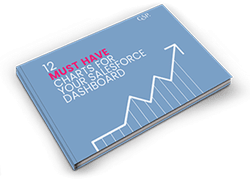
Don’t have time to read the entire Blog Post right now?
No problem.
You can download the entire “Your Sales Forecast Is Probably Wrong” eBook for free by completing the form below!




